![]() Web Site Home - Theology Home - Hierarchy Home - Locations Home - Education Home -
Stewardship Home -
Links Home -
Vendors Home - Alphabetical Index Home - Thesaurus Home - Sitemap Home - Arabic fonts
Web Site Home - Theology Home - Hierarchy Home - Locations Home - Education Home -
Stewardship Home -
Links Home -
Vendors Home - Alphabetical Index Home - Thesaurus Home - Sitemap Home - Arabic fonts
Melkite Greek Catholic Church Information Center
Acathist Hymn / Akathist Hymn / Hymn of the Akathistos / Al Madaayeh for Jubilee 2000 on December 8
General Information
The Acathist Hymn / Hymn of the Akathistos celebration in the Basilica of
Saint Mary Major / Basilica di Santa Maria Maggiore in Rome on December 8, 2000
was the Jubilee 2000 event for the Byzantine Rite (nonslavs). Pope John Paul II celebrated.
Retired His Beatitude, Maximos V, Patriarch / Batriyark of the cities of Antioch, Alexandria and Jerusalem, of Cilicia, Syria, Iberia, Arabia Mesopotamia, Pentapolis, Ethiopia, of all of Egypt and the entire East, Father of Fathers, Pastor of Pastors, Bishop of Bishops, the Thirteenth of The Holy Apostles, and his successor, His Beatitude, Gregorios III, Patriarch / Batriyark of the cities of Antioch, Alexandria and Jerusalem, of Cilicia, Syria, Iberia, Arabia Mesopotamia, Pentapolis, Ethiopia, of all of Egypt and the entire East, Father of Fathers, Pastor of Pastors, Bishop of Bishops, the Thirteenth of The Holy Apostles, were represented by the Patriarchal Vicar in Damascus,
Archbishop Isidore of Pelusium.
Also, His Excellency, Bishop John Elya concelebrated. Plus, Archimandrite Philip Razcka attended.
It was wonderful! I am glad that I attended! The chiors were like angels singing. I was transported. It was the most wonderful event, a heavenly event. Most of the time my eyes were closed. When I opened my eyes, I could see a mystical view straight up the center aisle: the wonder-working Ikon of The Theotokos "salus populi romani" and the wonderful candles and their light. As I was slowly coming down from the singing, I watched the Pope and all the celebrants walk slowly down the center aisle.
These pictures were purchased from l'Obsservatore Romano in Vatican City. If you would like a copy of these pictures, please order them from l'Obsservatore Romano. The ordering number is next to each picture. Also, the tape purchased was purchased from Centro Televisivo Vaticano, CTV in Vatican City.
When I arrived home, I was greeted with the message that my cousin unexpectly dropped dead two days before! He was buried 3 days before Christmas. I am still in a state of shock about his death! So, this page became very low priority. Some items that I wished to obtained from the Vatican's Web site were not obtained. Also, the shock erased some items about the "AKATHISTOS" from my mind.
Information from the Holy See's Web Site
HYMN OF THE "AKATHISTOS"
SOLEMNITY OF THE IMMACULATE CONCEPTION
December 8, 2000
INTRODUCTION
1. One of the chief moments of prayer which the Holy Father desired for the Great Jubilee of the Year 2000 is the liturgical chant of the Akathistos Hymn in the Byzantine Rite on the evening of the Solemnity of the Immaculate Conception. In this way, with the approach of Christmas, the holy Mother of God will be honoured in the words of an outstanding text of the Eastern tradition.
2. The Celebrants. His Holiness Pope John Paul II will preside at the celebration in the Basilica of Saint Mary Major in Rome, together with representatives of various Byzantine Catholic Churches. On other occasions, the Holy Father has either expressed a desire for the Akathistos Hymn to be chanted or has presided at the chant himself: in 1981, to commemorate the anniversaries of the First Council of Constantinople (381) and the Council of Ephesus (431); and during the Marian Year 1987-1988, as a means of highlighting the Solemnity of the Annunciation (Al Bisharah) on 25 March. In order to give expression to the principal languages of the Churches of the Byzantine tradition, the Akathistos Hymn will be sung in Greek, Old Slavonic, Hungarian, Ukrainian, Romanian and Arabic.
3. The ritual. The approaching feast of Christmas is the heart of what the Great Jubilee commemorates. The Jubilee commemoration of the Birth of Jesus Christ confers special significance on this celebration of the Akathistos Hymn. Indeed, 'the joy of the Jubilee would not be complete if our gaze did not turn to her who in full obedience to the Father gave birth to the Son of God in the flesh for our sake. For Mary 'the time to give birth' came to pass in Bethlehem (Lk 2:6), and filled with the Spirit she brought forth the first 'born of the new creation' (John Paul II, Incarnationis Mysterium, 14). The Akathistos Hymn is the ideal patristic and liturgical text for celebrating the Mother of God in the mystery of Christ and the Church as Christmas approaches. The season of Advent now being celebrated by the Latin Rite and some of the Oriental Rites makes even more appropriate this manner of celebrating 8 December. This is the day when Christians of the West commemorate the Solemnity of the Immaculate Conception as the great moment of preparation for the Saviour's coming, and Christians of the East celebrate the Vespers of Saint Anne's Conception, which they regard as the last in a series of purifying gifts of grace marking humanity's journey from Adam to Christ: after Christ, Mary is the most exalted fruit of divine grace and human supplication. For this reason, some of the texts used in the celebration refer to Joachim and Anne, Mary's righteous parents, to whom it was granted to receive from God the Virgin Mother according to the promise, and to return her to God as an offering in the name of all. This celebration of the Akathistos Hymn also suggests and confirms the ecumenical character of the Jubilee, which the Holy Father is keen to promote: "Such a wealth of praise, built up by the different forms of the Church's great tradition, could help us to hasten the day when the Church can begin once more to breathe fully with her 'two lungs', the East and the West" (John Paul II, Redemptoris Mater, 34).
4. The celebration. In the Byzantine liturgy from which it is taken, the Akathistos was originally celebrated on the fifth Saturday of Lent, which was therefore called "Saturday of the Akathistos": and this not only because of its proximity to the feast of the Annunciation, in which a passage from the Akathistos still appears, but also because this Hymn, a matchless gem of Marian theology and spirituality, links the mystery of Christmas to the mystery of Easter, the birth of the Word made flesh to the Passover of his Death and Resurrection and our rebirth through the sacraments of regeneration, the motherhood of Mary at Bethlehem to her maternal presence at the baptismal font. Today's celebration underlines the fundamental character of the Hymn: its articulation of the entire Christmas cycle, which makes it 'a far' reaching remembrance of the divine motherhood, virginal and salvific, of the one whose 'spotless virginity gave the Saviour to the world' ' (Paul VI, Marialis Cultus, 5).
The celebration comprises many elements. All are centred on the Akathistos Hymn itself, set in a broader context of prayer which, as in other Byzantine celebrations, includes litanies, the Trisagion, the Our Father, troparia, psalms and psalmodic verses.
A place of honour is given to the 'poetical canon' of Joseph the Hymnodist ( 886), composed precisely for the celebration of the Akathistos, as a framework to give it greater lustre. Like most poetic canons, it consists of nine odes inspired by the nine biblical canticles from the Byzantine Morning Office (the second ode is omitted, being reserved to penitential seasons). The canon of Joseph is inspired by the themes of the Akathistos, but re-reads them in a different devotional setting, more laudatory and symbolic in temper.
5. The Akathistos Hymn. It is fitting to give a fuller introduction to the Hymn itself, for it is the heart of the celebration and as it were a declaration of the Marian doctrine and piety of the Churches of the Byzantine Rite. Besides celebrating it on the fifth Saturday of Lent and singing a section of it on the four preceding Saturdays, monks, priests and faithful recite the Hymn on many other occasions, even every day, because they have an instinctive sense of its beauty and depth of meaning. Almost all Byzantine monasteries and churches contain painted scenes from the Akathistos on the walls oftheir sacred buildings, on vestments, on liturgical furnishings, or surrounding the most celebrated ikons.
Name. Akathistos is the title by which this fifth century Byzantine Hymn is universally known. It was and still is the model for the composition of many other hymns and litanies, both ancient and more recent. Akathistos is not the original title, but a rubric:'a-kathistos' in Greek means 'not-seated', because the Church stipulates that it be sung or recited 'standing', as when the Gospel is read, as a sign of reverence for the Mother of God.
Structure. The metric and syllabic structure of the Akathistos is inspired by the description of the heavenly Jerusalem in Chapter 21 of the Book of Revelation, from which it draws images and numbers: it sings of Mary in her identification with the Church, the 'Bride' with no earthly spouse, the Virgin Bride of the Lamb, in all her splendour and perfection.
The Hymn comprises 24 stanzas (in Greek oikoi), which is the number of letters in the Greek alphabet, and the whole is structured according to the alphabet, each stanza beginning with the succeeding letter. But it was skilfully planned in two distinct parts, on the two closely related and superimposed planes of history and faith, and according to the two interwoven and complementary perspectives of Christology and ecclesiology, which envelop and illumine the mystery of the Mother of God. Each of the Hymn's two parts is in turn very subtly subdivided into two sections of 6 stanzas: this subdivision is clearly presented in today's liturgical celebration. Yet the Hymn unfolds in a binary mode, in such a way that each odd-numbered stanza finds its metrical and conceptual equivalent in the even stanza which follows. The odd stanzas are amplified by 12 Marian salutations, gathered around their narrative or dogmatic centre, and they finish with the ephymnion or closing refrain: 'Hail, Bride unwedded!' By contrast, the even stanzas, after announcing the theme, which is almost always Christological in background, ends with the acclamation to Christ: 'Alleluia!' Thus the Hymn is both Christological and Marian, with the Mother subordinate to the Son and the maternal mission of Mary subordinate to the universal saving work of the one Saviour. The first part of the Akathistos (stanzas 1-12) follows the cycle of Christmas, drawing its inspiration from the Infancy Narratives of the Gospels (Lk 1-2; Mt 1-2).
It sets forth in song the mystery of the Incarnation (stanzas 1-4), the outpouring of grace upon Elizabeth and John (stanza 5), the revelation to Joseph (stanza 6), the adoration of the shepherds (stanza 7), the arrival and adoration of the Magi (stanzas 8-10), the flight into Egypt (stanza 11), the meeting with Simeon (stanza 12). These are events which transcend the historical facts and become a symbolic reading of grace poured out, of the creature receiving grace, of the shepherds proclaiming the Gospel, of those from distant lands who come to faith, of the People of God which, rising from the baptismal font, goes forth on its light-filled way towards the Promised Land and comes to a profound knowledge of Christ.
The second part (stanzas 13-24) sets forth and sings of what the Church at the time of Ephesus and Chalcedon professed concerning Mary, within the context of the mystery of her Son the Saviour and of the Church which gathers all who are saved.
Mary is the new Eve, a virgin in both body and soul, who by the fruit of her womb leads mortals back to Paradise lost (stanza 13); she is the Mother of God who, in becoming the seat and throne of the Infinite One, opens the gate of heaven and leads us humans through (stanza 15); she is the Virgin who gives birth and reminds us to bow down before the mystery of the divine birth and to draw light from faith (stanza 17); she is the ever-Virgin, the dawn of the virginity of the Church consecrated to Christ, the Church's unfailing ward and loving protector (stanza 19); she is the Mother of the Easter sacraments, which purify and divinize us and feed us with heavenly food (stanza 21); she is the Holy Ark and the living Temple of God, who goes before and watches over the Church and the faithful on their pilgrim way towards the final Easter (stanza 23); she is the Advocate of mercy on the last day (stanza 24).
Theological value. The Akathistos is a truly inspired composition of immense importance:
- because of its sense of salvation history, embracing the entire plan of God for creation and for creatures, from the origins to the very end, towards the fullness which will be theirs in Christ;
- because of its pure sources: the word of God in the Old and New Testaments, always present either explicitly or implicitly; the doctrine defined by the Councils of Nicaea (325), Ephesus (431) and Chalcedon (451), from which it draws directly; the doctrinal treatises of the greatest of the Eastern Fathers of the fourth and fifth centuries, from whom it takes concepts and lapidary formulations;
- because of its knowing mystagogical approach, by means of which - adopting the most eloquent imagery from creation and Scripture - it raises the mind step by step and brings it to the threshold of the mystery contemplated and celebrated: the mystery of the Incarnate Word and Saviour, the mystery which, as the Second Vatican Council affirms, indicates in Mary the 'place' where the principal elements of the faith converge and echo forth to the world (cf. Lumen Gentium, 65).
Author. Almost the entire manuscript tradition considers the Akathistos Hymn to be the work of an anonymous author. The Latin translation edited by Bishop Christopher of Venice, around the year 800, which had a great influence on the piety of the mediaeval West, bears the name of Germanus of Constantinople ( 733). Today however scholars tend to attribute its composition to one of the Fathers of Chalcedon: as such, this venerable text would be the mature fruit of the most ancient tradition of the undivided Church of the first centuries. In this year of the Great Jubilee, therefore, it deserves to be taken up and sung by every Church and Ecclesial Community.
The Hymn is anonymous: and rightly so, for thus it belongs to everyone, because it belongs to the Church.
Holy See's Web Site The same news release as above but in Italian.
CELEBRAZIONE DELL'INNO AKATHISTOS
NELLA SOLENNITÀ DELL'IMMACOLATA CONCEZIONE DELLA B.V. MARIA
8 dicembre 2000
PRESENTAZIONE
homily of Pope John Paul II from the Holy See's Web Site
CELEBRAZIONE DELL’INNO AKATHISTOS NELLA BASILICA DI SANTA MARIA MAGGIORE , 08.12.2000
CELEBRAZIONE DELL'INNO AKATHISTOS NELLA BASILICA DI SANTA MARIA MAGGIORE
Alle ore 17, dopo l'omaggio alla statua dell'Immacolata in Piazza di Spagna, il Papa raggiunge la Patriarcale Basilica di Santa Maria Maggiore per la celebrazione, in questo Anno Giubilare, dell'Inno Akathistos in rito bizantino.
La celebrazione è presieduta dal Santo Padre, con la partecipazione di Rappresentanti di varie Chiese bizantine cattoliche. L'inno Akathistos è cantato nelle lingue greca, paleoslava, ungherese, ucraina, romena ed araba.
Al termine del canto delle 24 stanze di cui si compone l'inno Akathistos, Giovanni Paolo II tiene la seguente omelia:
OMELIA DEL SANTO PADRE
1. Maria "è icona della Chiesa, simbolo e anticipo dell'umanità trasfigurata dalla grazia, modello e sicura speranza per quanti muovono i loro passi verso la Gerusalemme del cielo" (Lett. ap. Orientale lumen, 6).
Carissimi Fratelli e Sorelle! Eccoci raccolti nella Basilica che il popolo romano, all'indomani del Concilio di Efeso, ha dedicato con devoto fervore alla Santa Vergine Maria. Questa sera la tradizione liturgica bizantina celebra i primi Vespri della Concezione di sant'Anna, mentre la liturgia latina rende lode all'Immacolata Concezione della Madre di Dio.
Esprimo il mio vivo compiacimento per la partecipazione di una corona di Fratelli e Sorelle, che sono qui con noi questa sera in rappresentanza delle Chiese orientali cattoliche. Rivolgo il mio cordiale saluto a tutti i Vescovi di rito bizantino presenti in questa Basilica insieme con i loro fedeli.
2. Questa sera siamo tutti pervasi d'intima gioia: la gioia di rendere lode a Maria con l'Inno Acatisto, tanto caro alla tradizione orientale. E' un cantico tutto centrato su Cristo, contemplato nella luce della sua Vergine Madre. Per ben 144 volte esso ci invita a rinnovare a Maria il saluto dell'Arcangelo Gabriele: Ave Maria!
Abbiamo ripercorso le tappe della sua esistenza e reso lode per i prodigi in Lei compiuti dall'Onnipotente: dalla concezione verginale, inizio e principio della nuova creazione, alla sua divina maternità, alla condivisione della missione del suo Figlio, specialmente nei momenti della sua passione, morte e risurrezione.
Madre del Signore risorto e Madre della Chiesa, Maria ci precede e ci conduce all'autentica conoscenza di Dio e all'incontro con il Redentore. Ella ci indica la via e ci mostra il Figlio suo. Nel celebrarla con gioia e gratitudine, noi onoriamo la santità di Dio, la cui misericordia ha fatto meraviglie nella sua umile ancella. La salutiamo con il titolo di Piena di grazia ed imploriamo la sua intercessione per tutti i figli della Chiesa che, con quest'Inno Acatisto, celebra la sua gloria.
Ella ci guidi a contemplare, nel prossimo Natale, il mistero di Dio fatto uomo per la nostra salvezza! [02765-01.01] [Testo originale: Italiano]
The following text is an unoficial translation of the above official text from the Holy See.
CELEBRATION OF THE AKATHIST HYMN IN THE BASILICA OF SAINT MARY MAJOR
DECEMBER 8, 2000
At 5 P.M., after the homage to the statue of the Immaculate in the Piazza de Spagna, the Pope reentered the Patriarchal Basilica of Saint Mary Major for the celebration, in the Holy Year, of the Akathist Hymn in the Byzantine rite.
The celebration was presided over by the Holy Father, with the participation of representatives of various Byzantine Catholic Churches. The Akathist Hymn was sung in the Greek, Old Slavonic, Hungarian, Ukrainian, Romanian and Arabic tongues.
At the end of the singing of the 24 stanzas of which the Akathist hymn is composed, John Paul II gave the following homily:
HOMILY OF THE HOLY FATHER
1. Mary "is an icon of the Church, the symbol and anticipation of humanity transfigured by grace, the model and the unfailing hope for all those who direct their steps towards the heavenly Jerusalem." (Ap. Let. Orientale Lumen, 6)
Most Dear Brothers and Sisters! Behold yourselves gathered int the Basilica which the Roman people, in the aftermath of the Council of Ephesus, have dedicated with devote fervor to the Holy Virgin Mary. This evening the Byzantine liturgical tradition celebrates the first Vespers of the Conception of Saint Anne, while the Latin liturgy renders praise to the Immaculate Conception of the Mother of God.
I express my lively pleasure for the participation of a crown of brother and sisters, who are here with us this evening in representation of the Eastern Catholic Churches. I address my cordial welcome to all the bishops of the Byzantine Rite present in this Basilica together with their faithful.
2. This evening, we are all pervaded with an inward joy, the joy of rendering praise to Mary with the Akathist Hymn, so dear to the Eastern tradition. It is a canticle totally centered on Christ, contemplated in the light of His Virgin Mother. For a full 144 times, this hymn invites us to renew to Mary the greeting of the Archangel Gabriel: "Ave Maria!"
We have retraced the stages of her existence and rendered praise for the wonders fulfilled in her by the Omnipotent: from the virginal conception, beginning of the new creation, to her divine maternity, to her sharing in the mission of her Son, especially in His suffering, death and resurrection.
Mother of the risen Lord and Mother of the Church, Mary precedes us and leads us to the authentic knowledge of God and to the encounter with the Redeemer. She points out to us the way and shows us her Son. In celebrating her with joy and gratitude, we honor the holiness of God, Whose mercy has done marvels in His humble handmaid. We salute her with the title of "Full of grace" and implore her intercession for all the children of the Church who with this Akathist Hymn celebrate her glory.
She guides us to contemplate, in the coming Christmas, the mystery of God made man for our salvation!
Sharing the Acathist Hymn for Jubilee 2000 (12/26/00) from the Diocese of Newton's Web site.
Pictures of the ceremony
The pictures below are from the Holy See's Web Site.
8 Friday Homage to the Immaculate Basilica of Saint Mary Major, at 5.00 p.m. Hymn of the "Akathistos" Click on ...a moment during the liturgy Click on Some pictures (skip the first two pictures) pictures from the Holy See's Web site.
The pictures below purchased from l'Obsservatore Romano in Vatican City.
View of wonder-working Ikon of The Theotokos "salus populi romani" and the two minor ikons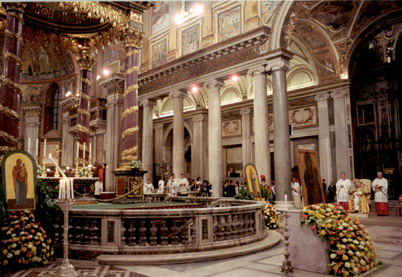
Order number 419
Pope John Paul II and Bishops - Pope John Paul II bowing to The Theotokos - Patriarchal Vicar in Damascus,
Archbishop Isidore of Pelusium is in the first row in blue - Eparch John
Elya of the Diocese of Newton is in the second row, second to the right of the Patriarchal Vicar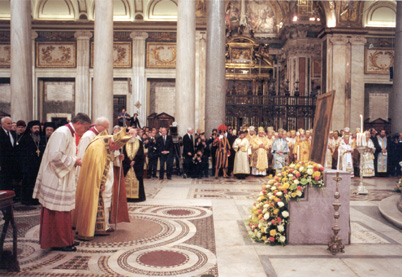
Order number 381
AKATHISTOS - Pope John Paul II and Bishops bowing to each other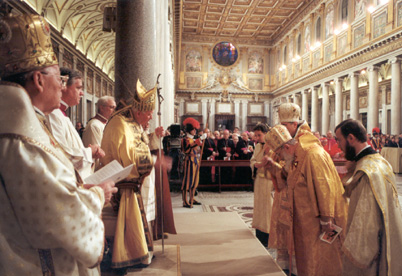
Order number 387
AKATHISTOS - incensing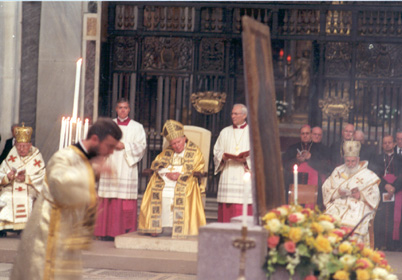
Order number 388
AKATHISTOS - bishop leading pray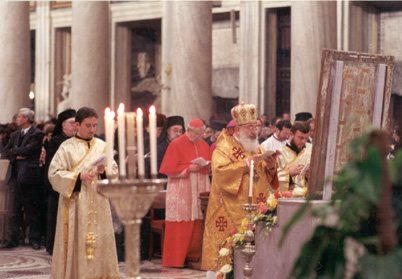
Order number 408
Bishops - Patriarchal Vicar in Damascus,
Archbishop Isidore of Pelusium has the empty chair in the first row - Eparch John
Elya of the Diocese of Newton is in the second row, 3 people to the right of the Patriarchal Vicar's chair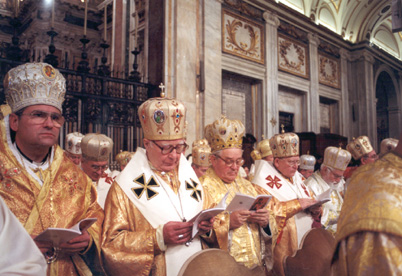
Order number 421
Pope John Paul II's speech after AKATHISTOS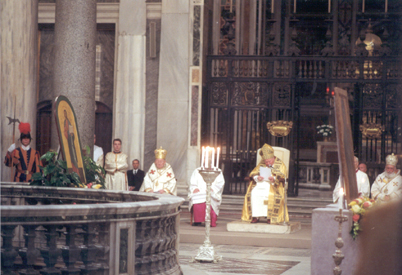
Order number 311
Patriarchal Vicar in Damascus,
Archbishop Isidore of Pelusium meeting with John Paul II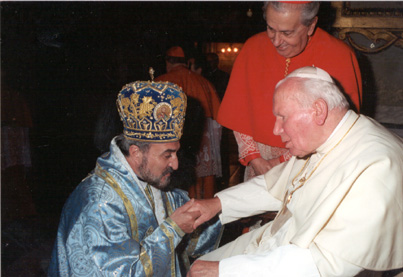
Order number 463
Eparch John
Elya of the Diocese of Newton meeting with John Paul II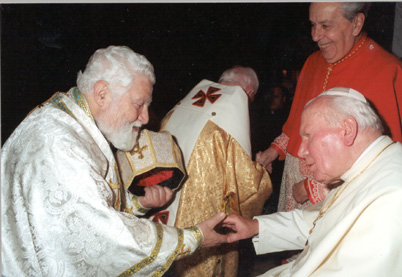
Order number 476
Web Site Home - Theology Home - Hierarchy Home - Locations Home - Education Home - Stewardship Home - Links Home - Vendors Home - Alphabetical Index Home - Thesaurus Home - Sitemap Home - Arabic fonts
Melkite Greek Catholic Church Information Center
Martha Liles
Web URL address: Melkite Greek Catholic Church Information Center or https://www.mliles.com/melkite/
E-mail: mliles@mliles.com or mliles@mliles.com
Melkite Greek Catholic Church Information Center is
an unofficial Melkite Greek Catholic Web site and has not been reviewed or
approved by any Melkite clergy person.
Melkite Greek Catholic Church Information Center contains a range of World Wide Web sites on Melkite faith, belief, practice, history, etc. Melkite Greek Catholic Church Information Center
does not endorse any World Wide Web site nor takes any responsibility for the contents of any World Wide Web site. Melkite Greek Catholic Church Information Center
offers these links with the understanding that Melkite Greek Catholic Church Information Center can not vouch for
any of the contents on each site. Listing a site does not indicate acceptance nor endorsement of the doctrines / ideas / theology of the
World Wide Web site. Please remember that Web sites will change their content and their location. It is the user's responsibility to decide whether
or not the content on a particular World Wide Web site is appropriate.
Melkite Greek Catholic Church Information Center is
dedicated to my cousins: Bucky (Richard C. Liles), Shirley (Shirley Jean Liles Buck), and Donna (Donna Bertha Liles Campbell). Bucky fell asleep in
the Lord on Dec. 12, 2000, Shirley fell asleep in the Lord on Nov. 8, 2001, and Donna fell asleep in the Lord on March 9, 2020.
O God of all spirits and of all flesh, who have destroyed death, overcome the devil, and given life to the world: grant, O Lord, to the souls of your servants
Bucky and Shirley, who has departed from this life, that it may rest in a place of light, in a place of happiness, in a place of peace, where there is no pain, no
grief, no sighing. And since You are a gracious God and the Lover of Mankind, forgive him/her every sin he/she has committed by thought, or word, or deed, for
there is not a man who lives and does not sin : You alone are without sin, your righteousness is everlasting, and your word is true. You are the Resurrection and
the Life, and the repose of your departed servants Bucky and Shirley. O Christ our God, and we send up glory to You, together with your eternal Father and your
all-holy, good and life-giving Spirit, now and always and for ages upon ages. Amen.
This site copyright©2000,2001,2002,2003,2004,2005,2006,2007,2008,2009,2010,2011,2012,2013,2014,2015,2016,2017,2018,2019,2020 Martha Liles. All rights reserved.
Last Updated: Wednesday, June 03, 2020, 16:45:40, CDT
The current date and time is: Friday, April 26, 2024, 23:10:56, CDT or Saturday, April 27, 2024, 04:10:56, GMT